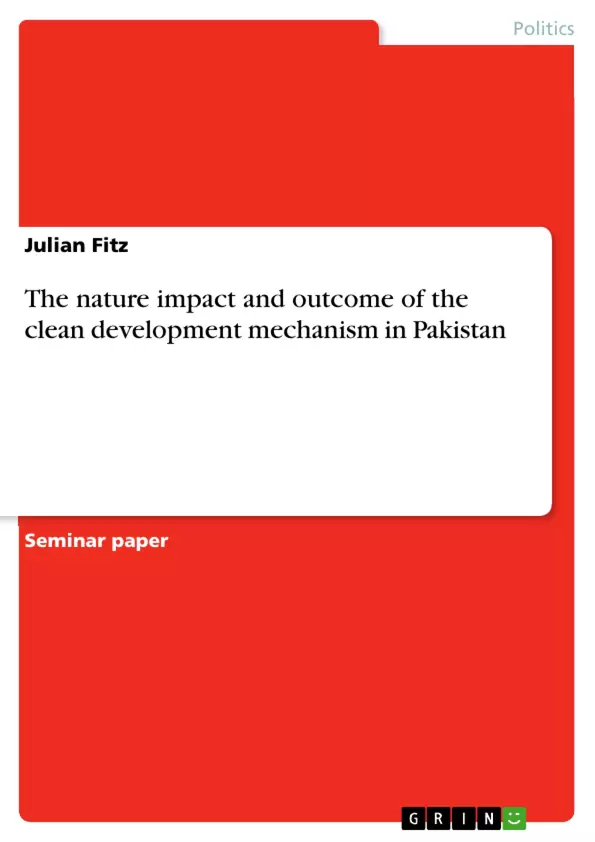The main goal of this essay is to take a quick look at the nature of the CDM in Pakistan, analyse its impact on the country and finally assess what the outcome looks like. What is the CDM doing with Pakistan? How and where has it worked? Has it spurred any local effects? To this end I will start out by giving an overview of Pakistan’s current emissions and possible CDM approaches and then take a close look at all 29 registered CDM projects. I will also assess whether these projects have had an impact on Pakistan’s overall emission pattern and whether some form of technology transfer has taken place. In a second major part of this essay I shall try to identify the effects that the CDM has had and if it has been able to spur local development within the government, the economy or academia and civil society.
Inhaltsverzeichnis (Table of Contents in English)
- Introduction
- What is the CDM
- Emissions and CDM projects in Pakistan
- Pakistan's emissions past and present
- CDM projects in Pakistan
- Effect of CDM on Pakistan's emissions and technological development
- How has the CDM influenced Pakistan? A brief progress report
- Government
- Economy
- Academia
- Civil Society
- Conclusion
Zielsetzung und Themenschwerpunkte (Objectives and Key Themes in English)
This essay aims to analyze the nature, impact, and outcome of the Clean Development Mechanism (CDM) in Pakistan. It explores how the CDM has affected the country's emissions, technological development, and overall progress toward sustainable development. The essay examines the CDM's influence on various sectors within Pakistan, including government, economy, academia, and civil society. Here are some key themes explored within the text:- The role of the CDM in mitigating climate change
- The impact of CDM projects on Pakistan's emissions and technology
- The benefits and challenges of the CDM for developing countries
- The economic implications of the CDM for Pakistan
- The CDM's influence on various stakeholders in Pakistan
Zusammenfassung der Kapitel (Chapter Summaries in English)
- Introduction: This chapter introduces the global threat of climate change and the UNFCCC's response through mitigation and adaptation strategies. It highlights the Kyoto Protocol's aim to reduce emissions in developed countries and introduces the Clean Development Mechanism (CDM) as a market-based solution for achieving emission reduction targets. The chapter emphasizes the CDM's significant investment potential, particularly for developing countries like Pakistan. It also highlights Pakistan's vulnerability to climate change and its commitment to combating it through the UNFCCC.
- What is the CDM?: This chapter defines the Clean Development Mechanism (CDM) as one of the Kyoto Protocol's flexible mechanisms for achieving emission reductions. It explains how the CDM functions, with Annex I countries mitigating emissions in developing countries and earning Certified Emission Reductions (CERs) in return. The chapter underscores the CDM's dual goals of assisting developing countries in achieving sustainable development and providing Annex I countries with cost-effective emission reduction options.
- Emissions and CDM Projects in Pakistan: This chapter examines Pakistan's historical and present emissions patterns and its engagement with the CDM. It discusses the number of registered CDM projects in Pakistan and their potential impact on emissions and technological development. The chapter analyzes Pakistan's position among other Non-Annex I countries in terms of CDM projects and emissions levels.
- How has the CDM Influenced Pakistan? A Brief Progress Report: This chapter delves into the effects of the CDM on various sectors in Pakistan. It explores the CDM's impact on government policies, economic development, academic research, and civil society initiatives. The chapter evaluates the extent to which the CDM has fostered sustainable development and its implications for various stakeholders in Pakistan.
Schlüsselwörter (Keywords in English)
The primary focus of this essay is the Clean Development Mechanism (CDM) and its implications for Pakistan. Key terms and concepts include climate change, greenhouse gas emissions, sustainable development, investment, technology transfer, emission reduction targets, and the Kyoto Protocol. The essay also explores various stakeholders in Pakistan, such as government, economy, academia, and civil society, and their roles in the CDM framework. Additionally, concepts like Certified Emission Reductions (CERs), Official Development Aid (ODA), and vulnerability to climate change are central to the analysis.- Citar trabajo
- Julian Fitz (Autor), 2013, The nature impact and outcome of the clean development mechanism in Pakistan, Múnich, GRIN Verlag, https://www.grin.com/document/230218



